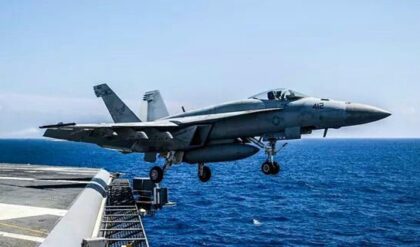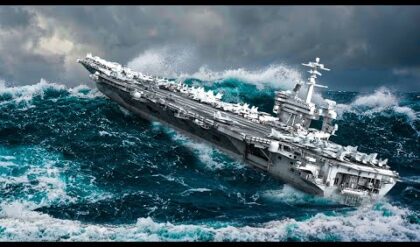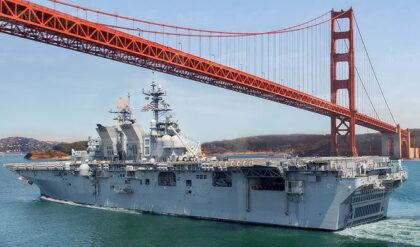Defence Minister Rajnath Singh recently said India would soon begin building its third aircraft carrier, even as China’s third and latest carrier completed its maiden test voyage
)
Combined Operations Of Indian Navy’s Two Aircraft Carriers, INS Vikramaditya And INS Vikrant. Photo Credit: PIB
Following close on the heels of China’s third and latest aircraft carrier completing its maiden test voyage, Defence Minister Rajnath Singh on Tuesday said that India would soon commence building its third aircraft carrier, adding that New Delhi has plans to make “five or six more”.
Singh made these remarks in reference to the pending Indian Navy proposal to build another indigenous aircraft carrier, which will be of the same size as the INS Vikrant at 45,000 tonnes.
The defence minister’s comments to the media provide an indication of the country’s long-term carrier building plans. “We will not stop at that (three aircraft carriers). We will make five, six more,” Rajnath told an English daily.
At present, the Indian Navy operates two 45,000-tonne aircraft carriers, the INS Vikramaditya and the INS Vikrant. Both are conventionally-powered and use ski-jump ramps to assist aircraft takeoff.
The INS Vikrant, India’s first indigenous carrier constructed by Cochin Shipyard Ltd, was commissioned in September 2022, while the INS Vikramditya was bought from Russia and deployed in 2014.
On May 8, China’s third aircraft carrier, the Fujian, returned after completing its maiden test voyage. At present, the Chinese People’s Liberation Army Navy (PLAN) operates two conventionally-powered, ski-jump ramp aircraft carriers, the 60,000 tonne-class Liaoning and Shandong.
Unlike its predecessors, the 80,000 tonne-class Fujian will launch its aircraft using three electromagnetic catapults.
These catapults are powered by an electromagnetic system similar to that of the US Navy’s Gerald R Ford-class carrier and are more advanced than the ski-jump mechanism used by Indian and other Chinese carriers.
)
China’s third aircraft carrier, the Fujian, during its maiden sea trials. Photo credit: Xinhua
But, India and China aren’t the only Asian nations building aircraft carriers, often described as “floating sovereign airfields”. In fact, the defence minister’s remarks, coupled with developments in other Asian countries, signal the advent of a regional aircraft carrier race.
Japan unveils first aircraft carrier since Second World War
)
Japanese Maritime Self-Defense Force’s aircraft carrier Kaga. Image credit: Japan Maritime Self-Defense Force (Twitter/X)
In April, Japan’s Maritime Self-Defense Force (MSDF) unveiled its upgraded helicopter carrier Kaga, after completing the first stage of modifications to turn the warship into an aircraft carrier. Once operational, the Kaga will carry Lockheed Martin F-35B Lightning II Joint Strike Fighter jets, which will be acquired by Japan.
The modified Kaga’s unveiling means that Japan is one step closer to operating its first full aircraft carrier since the Second World War.
The Kaga’s upgrade took two years and includes coating heat-resistant paint on its deck, which will now be also to withstand the exhaust heat caused by the F-35B stealth fighter’s takeoff and vertical landing.
Other structural modifications have been made to the Kaga to ensure a safe takeoff for aircraft.
The Kaga is one of the two Izumo-class helicopter carriers operated by Japan’s MSDF. With a length of 248 metres and a standard displacement of 19,950 tonnes, these are the MSDF’s biggest vessels.
Izumo, the second ship of the class, is also undergoing similar modifications to operate F-35B jets, with the process of making its deck heat-resistant already completed.
Japanese media had reported in April that further modifications to the Izumo were scheduled to start soon.
South Korea also wants its own aircraft carrier
In October 2020, Jane’s Defence had reported that driven by the growing naval capabilities of neighbouring countries, South Korea’s Joint Chiefs of Staff had called for expediting plans to construct an aircraft carrier.
Subsequently, South Korean officials held the first meeting for building a next-generation aircraft carrier.
The meeting was described as “the first step” towards developing “core technologies” for designing and building a light aircraft carrier. According to the report, the development process was expected to be completed by 2024.
Initially, the project envisioned building a 40,000-tonne carrier, which would operate with short take-off and vertical landing F-35B jets.
However, recent developments suggest that the fate of South Korea’s future carrier is uncertain.
In December 2023, Naval News reported that the 2024-2028 mid-term defence blueprint released by the South Korean Ministry of National Defense did not include detailed plans or a timeline for the proposed aircraft carrier. However, the blueprint did state that the carrier project would be pursued in the future.
According to the report, the South Korean government’s budget proposal for 2024 also did not include a budget for the carrier programme.
Over the years, the project has also grown in ambition, with the latest design of the proposed carrier opting for a catapult launch system and a displacement of up to 70,000 tonnes.
Chinese carriers could go nuclear
China’s Fujian is considerably larger than carriers made by India, the United Kingdom (UK), and France, but it is still conventionally powered. In comparison, all American carriers and the French Charles de Gaulle carrier are nuclear powered.
However, the Chinese Communist Party’s official mouthpiece reported in March that Beijing would unveil its fourth aircraft carrier soon, while speculating that there was a chance that the warship could be nuclear powered.
According to a 2022 report by US think tank Center for Strategic and Budgetary Assessment, China has the required resources to field up to five aircraft carriers by 2030.
The Pentagon’s 2023 annual report on China’s military power also warned that China was “in the beginning stages of operating what the People’s Liberation Army (PLA) calls its ‘multi-carrier force'”.
US still has the most aircraft carriers
A total of 21 aircraft carriers are in operation around the world, with the US alone accounting for 11, according to globalfirepower.com.
China, India, the UK and Italy have two carriers each, while France and Russia have one apiece.
The US also enjoys a qualitative advantage in this domain. In fact, China’s latest carrier, the Fujian, is still smaller than the US Navy’s latest Gerald R Ford-class carrier, which has a displacement of 100,000 tonnes.





